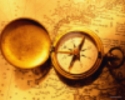Quiz Table
Answer
Letter
Questions and Answer Options
Answer 1
1.
Gillian Rose has argued that the painting _Mr. and Mrs. Andrews_ helps create _________
(see http://www.wga.hu/art/g/gainsbor/02andrew.jpg if you're curious)
a.
a backlash against wealthy landowners
b.
English national identity
c.
a shift in fashion tastes
d.
all of these are true
Answer 2
2.
Baudrillard (a very famous cultural theorist) discusses issues of authenticity and ___________, and how imagery is used to manipulate both.
a.
style
b.
environment
c.
logic
d.
power
Answer 3
3.
Sometimes the extraction of meaning is too easy. Why might this happen according to the text?
a.
We are probably missing the point of the image
b.
We already know all there is to know about the image
c.
We already know what we want the image to mean.
d.
None of these are correct
Answer 4
4.
The author suggests that you focus your attention on this concern as you interpret visual imagery:
a.
production of the image
b.
aesthetics of the image
c.
audience for the image
d.
all of these are concerns
Answer 5
5.
The author's brief discussion of the painting The Hay Wain could be used to support a discussion of:
a.
how there is little change in the symbolic quality of something like the world trade center
b.
how paintings are important markers of established political power
c.
the changing symbolic quality of the "rebel flag".
d.
all of these would be supported.
Answer 6
6
As the text discusses "signfication", the author claims that symbols evoke ________
a.
related images and ideas
b.
very clear and precise meanings
c.
meaning that is complete indivdualized
d.
minimalist meanings
Answer 7
7.
Why does Lewis suggest that landscapes are hard to read?
a.
They were not meant to be read
b.
We are not accostomed to reading landscapes
c.
Few academic disciplines bother to teach people to read the landscape
d.
all of these are correct
Answer 8
8
When places look alike, there is a good chance that they are quite a bit alike. This is the ___________ corollary.
a.
taste
b.
convergence
c.
similarity
d.
diffusion
Answer 9
9.
Which of these buildings would Lewis identify as the most important for understanding the U.S.?
a.
Wal-Mart
b.
the White House
c.
the Farm House
d.
none of these are more important than any other
Answer 10
10.
What is the cultural landscape, according to Lewis?
a.
essentiall the trees, schrubs and lawn ornamentation around your house
b.
those things essentially built before the age of mass production
c.
nearly everything you see when you go outside
d.
a style of painting that was popular in the 1800s
Answer 11
11.
Why would we want to study the landscape to better understand American culture? Why not just read up on it? According to Lewis:
a.
The landscape is our "unwitting autobiography" and as such may represent a unique vision of who we are
b.
There are no books on many subjects that have landscapes.
c.
Many books written about landscape objects don't often agree with each other.
d.
Lewis suggests all of these.
Answer 12
12.
If I were to try to do a paper on the landscapes of convenience stores, where does Lewis suggest I look?
a.
academic literature produced by architects
b.
encyclopedias
c.
trade journals produced by the convenience store industry
d.
cultural geography journals
Answer 13
13.
Who does Lewis identify as having a profound influence on academics (like Geographers) even though this person was not affiliated with any single discipline?
a.
J.B. Jackson
b.
Fred Kniffen
c.
Wibur Zelinsky
d.
George Stewart
Answer 14
14.
If something is completely unusual (like a hotdog stand shaped like a hotdog in Hollywood) on the landscape:
a.
it may not have much cultural signficance
b.
it may not be as unique as you think, because similar things might be out there
c.
it may be no easier or harder to understand than something quite common
d.
all of these are mentioned by Lewis
Answer 15
15.
The point Lewis is trying to make in his corrollary about historical lumpiness is:
a.
landscape tends to change in great leaps
b.
historical change is hard to witness on the landscape
c.
historical change is obscured by the great "lump" that landscape represents
d.
landscapes of past eras are obliterated rapidly by change
Answer 16
16.
What might be in a "geographer's" photo of a building that other photographers (such as architectural historians) might exclude?
a.
people walking down the street, obscuring the building
b.
the ugly wires and the parking lot next door
c.
the no parking sign in the front of the building
d.
the geographer would include all these to provide context
When you click the button below, you will be directed to a web page that shows your answers. The instructor will get a copy of this email as well, but you may want to keep a copy for your records. If you are curious about the correct answers, please bring your questions to class.



